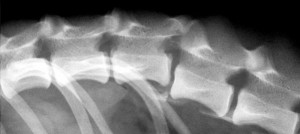News
Archive for August, 2019
Special Offer – August 2019
by admin on August 1st, 2019
Category: Special Offers, Tags:
Spinal Fractures
by admin on August 1st, 2019
Category: News, Tags:
Spinal Fractures
Fractures (breaks) of the spine occur when dogs and cats are involved in road traffic accidents or suffer other major trauma such as a fall or running into a patio door. Spinal fractures are often associated with varying degrees of injury to the spinal cord (the bundle of nerves inside the vertebrae) and, therefore, nerve damage. Although many animals may be paralysed as a result of the fracture, they will often recover, provided that they retain the ability to feel pain and that they are managed appropriately. Some cases can be treated medically, but it is often necessary to consider surgery to stabilise a fractured spine.
What is involved in a spinal fracture?
In a spinal fracture, the bones (vertebrae) of the spine break (fracture) or come apart from each other (dislocate or luxate). Fracture of the spine usually occurs as a result of a significant injury, such as being hit by a car, although occasionally the bones in the spine may fracture with minimal, if any, trauma because they are already weakened by a condition such as a tumour (referred to as a ‘pathological fracture’).
When the vertebrae of the spine fracture or dislocate (luxate) the associated vertebral displacement often injures the nerves of the spinal cord. The concussion and compression of the spinal nerves affects nerve function, and the signs that develop may vary from only mild weakness through to paralysis (inability to voluntarily move the limbs). Severely affected patients may become incontinent and lose the ability to feel pain in their limbs and tail.
How are spinal fractures diagnosed?
Physical examination of the patient by the specialist may enable detection of instability of the spine or abnormal alignment of the spine. Importantly, examination also enables assessment of the severity of any associated spinal cord injury – in particular, whether or not the patient can still feel pain.
X-rays (radiographs) are often obtained to look for evidence of fracture (or luxation) of the vertebrae and are generally sufficient to make a diagnosis in the majority of cases. Occasionally a more advanced imaging technique is preferred, to provide additional detail of the spine. CT scanning is particularly good at looking at the bony detail of fractures which may not be apparent on normal X-rays. MRI scanning is not so good at detecting damage to bones of the spine, but it is excellent for assessing any damage to the spinal cord.
How are spinal fractures managed?
Spinal fractures (and luxations) are often emergencies because of the associated spinal cord injury and risk of further damage. As a result, they need to be treated with the minimum of delay. Affected dogs and cats are often in significant pain, and care should be taken to avoid the handler being bitten or scratched. Patients should be moved with great caution in case the spine (vertebral column) is unstable, as further movement may aggravate the injury and any nerve damage. Strapping the patient to a rigid board may be helpful in some cases.
Some fractures of the spine may be treated conservatively without the need for surgery. This is particularly appropriate in patients with relatively stable vertebrae and minimal spinal cord injury. Conversely, dogs and cats with unstable fractured spines, those with significant spinal cord injuries and those in severe pain are often best treated surgically. Surgery aims to re-align and stabilise the affected vertebrae. The procedure most often involves placing screws or pins in the bones on either side of the fracture (or luxation) and securing them with either a plate or cement.
What is the outlook (prognosis) in patients with spinal fractures?
The outlook in dogs and cats with spinal fracture is primarily dependent on the severity of the spinal cord injury and how the patient is treated. Provided the ability to feel pain in the limbs and tail is maintained and the patient is managed appropriately, the outlook is generally good. Recovery may take a number of weeks (or even months in severely affected cases) and supportive care, including physiotherapy/hydrotherapy exercises, may be necessary. In contrast, patients with spinal fractures that can no longer feel pain are very unlikely to recover, no matter how they are treated, since the spinal cord injury is generally severe and irreversible.
Pet of the month – August 2019
by admin on August 1st, 2019
Category: Pet of the Month, Tags:
Our Pet of the Month is the delightful Rascal, seen here recovering from removal of his anal sacs. Rascal had the misfortune to suffer months of anal sac issues ranging from impaction to infection with associated pain and discomfort, making anal sac removal the only viable way forward.
What are the anal sacs?
The anal sacs are two small pouches located on either side of the anus at approximately the four o’clock and eight o’clock positions. The walls of the sac are lined with a large number of sebaceous (sweat) glands that produce a foul smelling fluid. The fluid is stored in the anal sacs and is released through a small duct or canal that opens just inside the anus. The anal sacs are commonly called ‘anal glands’. The sacs are present in both male and female dogs.
What is their function?
The anal sac secretion contains chemicals that act as territorial markers or ‘dog calling cards’. The secretions are similar to those produced by a skunk, which are used to repel enemies and alert other animals to their presence. Anal sac fluid is usually squeezed out by muscular contractions whenever the dog passes a bowel movement, providing a distinctive odor (or individual ‘scent signature’) to the feces. This is why dogs are so interested in smelling one another’s feces.
Why are the anal sacs causing a problem in my dog?
Anal sac disease is very common in dogs. The sacs frequently become impacted (plugged) usually due to inflammation of the ducts. The secretion within the impacted sacs will thicken and the sacs will become swollen and distended. It is then painful for your dog to pass feces. The secreted material within the anal sacs is an ideal medium for bacterial growth, allowing abscesses to form. Bacteria that are normally present in the feces can readily travel up the ducts and enter the sacs. In normal situations, the bacteria are flushed out when the secretions are expelled during a bowel movement. However, if the sacs are impacted, the fluid does not empty normally and they become infected. The fluid then becomes bloody and eventually the sacs become filled with pus, forming an anal sac abscess.
The abscess will appear as a painful, red, hot swelling on one or both sides of the anus. If the abscess bursts, it will release a quantity of greenish yellow or bloody pus. If left untreated, the infection can quickly spread and cause severe damage to the anus and rectum.
Another cause of recurrent anal sac disease is change in stool consistency. This can occur in dogs with gastrointestinal diseases such as food allergies and inflammatory bowel disease.
How will I know if my dog has anal sac problems?
The first sign is often scooting or dragging the rear along the ground. There may be excessive licking or biting, often at the base of the tail rather than the anal area. Anal sac disease is very painful. Even normally gentle dogs may snap or growl if you touch the tail or anus when they have anal sac disease. If the anal sac ruptures, you may see blood or pus draining from the rectum.
How is anal sac disease treated?
Treatment for impaction involves expressing or emptying the sacs. If the impaction is severe or if there is an infection, it may be necessary to flush out the affected sac to remove the solidified material. Since these conditions are painful, some pets require a sedative or an anesthetic for this treatment. Antibiotics are often prescribed and sometimes may need to be instilled into the sacs. Most dogs will require pain relief medications for several days until the swelling and inflammation have subsided. In advanced or severe cases, surgery may be necessary.
Problems with the anal sacs are common in all dogs, regardless of size or breed. If you are concerned that your pet may have an anal sac problem, call your veterinarian.
Is the condition likely to recur?
Some dogs will have recurrent anal sac impactions or abscesses. Overweight dogs tend to have chronic anal sac problems because their anal sacs do not empty well. Each impaction may cause further scarring and narrowing of the ducts, leading to recurrences that are even more frequent. If this condition recurs frequently, surgical removal of the sacs is indicated. If the cause of anal sac disease is change in stool consistency, prevention involves treating the underlying cause and may require changing the dog to a higher fibre diet.
Are anal sacs necessary for my dog? Will removal have any adverse effects?
Anal sacs produce the pungent smelling secretion that allows the dog to mark his or her territory. For our domesticated dogs, this is an unnecessary behavior and removal will not adversely affect your pet.
Are there any risks associated with surgical removal of the anal sacs?
Removal of the anal sacs is a delicate and specialized surgery. Some dogs will experience loose stools or lack of bowel control for one to three weeks following surgery. This occurs because the nerves controlling the anal sphincters (muscles that close the rectum) run through the soft tissues near the anal sacs. If the infection is deep and extensive it can be impossible to avoid damaging the nerves during the surgery. This damage resolves without further treatment in the majority of pets. In rare cases, the nerve damage is permanent and can result in fecal incontinence or the inability to control bowel movements, with constant leakage of feces from your dog’s anus.
As with any surgery, general anesthesia is required which always carries some degree of risk. Advances in anesthesia drugs and monitoring continue to decrease these risks. For dogs suffering from chronic or recurrent anal sac infection or impaction, surgical removal is the best option to relieve the pet’s pain.
What other problems can develop with the anal sacs?
Older dogs can develop cancer of the glands within the anal sacs called adenocarinoma. Therefore, it is very important to have your dog examined by a veterinary as soon as any of the above clinical signs are seen.




